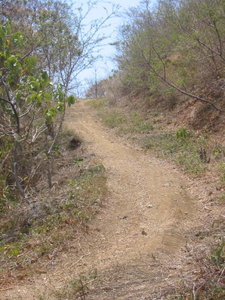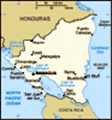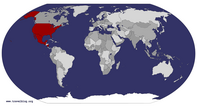Advertisement
Published: September 30th 2008

 A Road?
A Road?
Sometimes it was hard to tell if it was a road or just a trail!Having access to a vehicle was an essential part of our freedom to roam the countryside of Nicaragua. Most of the "roads" are dirt and in unbelievably bad shape. We literally had to hold on to our seats to keep from falling over while traveling on some of these roads. The huge potholes had to be constantly avoided or you could end up having to be pulled out of dangerous "craters". Driving at night was never a good idea, for many reasons, (some of which I'll touch upon in future blogs). Still, if you had a 4-wheel drive vehicle, like we did, driving could also be lots of fun and exciting! Playa Madera's, our favorite beach, was about 5 miles away along one of these "obstacle course" roads. There are a couple of ways one can get to this surfing beach from San Juan del Sur if you don't have a vehicle. Every morning, a big truck, stationed about a block away from the Market Place, and almost directly in front of our house, loads passengers in the back and surf boards on the side and for about $10.00 per person, will drive you, and about 15 other passengers, down the
bumpy road to the beach. The truck has huge tires and a high wheel base so it can clear the bumps. Ten dollars is a lot of money in Nicaragua, but vehicles take a beating driving on these roads, so very few taxis want to make the trip, or even can. As locals, we knew taxi drivers who we could hire for the day to take us to the beach and wait around to drive us back in the late afternoon. We did this if our car happened to be out of commission. The taxi driver wouldn't drop us off and come back to get us because that would mean another trip down that crazy road. The beach was only 5 miles away but most taxi drivers wouldn't go there, even for the ten dollars, because of the wear-and-tear on their vehicles. These cars are their only livelihood. Another way to get to this beach is by water taxi. This is a "Ponga" boat that goes from the SJDS Bay to the beach once a day (sometimes twice a day) and comes to get you in the late afternoon. The cost for this trip is between $10-15.00 dollars. There are
those who attempt to walk it or find a bicycle and try to ride to the beach, but as I said, these are bumpy, dusty, dirt roads with some BIG hills and if the heat doesn't get to you, the bugs will. There were many afternoons when we had to pick up people and throw their bikes on the roof because they looked like they weren't going to make it back to town before dark. By car, the 5 mile ride would often take us more than a half an hour. By bicycle, I had people tell me it had taken them HOURS to get there.
We met a lot of wonderful young people from all over the world, just because we went to the beach every afternoon and whoever could fit in our car could come along at no charge. The word got around quickly and people would show up at the house in the morning to introduce themselves and ask what time we were going to the beach. We often invited them in for tea and were privileged to hear wonderful and exciting travel stories in exchange for these afternoon rides. It was always on a "first
come, first serve" basis and sometimes the surfboards would get strapped on top of the car early in the mornings to secure an afternoon spot. I loved this. We met people from everywhere and some became regulars and dear friends. There were also the local young surfer guys who would give surfing lessons, for a couple of dollars in the afternoons, and sometimes needed a way to get to the beach. Walking down these roads there was always a laborer or a farmer going to the next "finca" that could be many miles away. They would raise a hand as we drove by. Sometimes the hand was holding a machete (the local "everything" work tool). At first, I thought these people were just waving a hello to us as we drove past, but we soon found out that it meant they could use a ride. So, we'd pick them up too. But I always insisted the machetes be secured to the roof. There were times, when I had in my car, a Canadian, an Australian, a German couple, a native local surfer, and a rancher with a few teeth missing and a huge cowboy hat. Sometimes, people didn't speak Spanish

 Water Taxi to the Beach
Water Taxi to the Beach
View of Playa Maderas Rock from the Ponga boator English so we had to use sign language, but it was never a problem. Our car was often like the United Nations. We met a lot of people and made a lot of friends by just being friendly and generous. Some of these people would change our lives forever.
Two such people were a couple we met from Austria. These were two friends, a young man and woman that were traveling together during a break from work. She, Marie, was a beautiful "free spirit" with a dazzling joyful smile and an itch for learning how to surf, and he, Hugo, was a nurse and teacher of meditation and Yoga, with a wild curious streak and an adventurous spirit. They became regulars on our afternoon beach rides and we were soon fast friends. Hugo wanted to pay us back for the rides in some way and offered to teach us Yoga. My daughter and I had always been drawn to yoga and she had even been in an after-school yoga club. We jumped on the chance to get private lessons. He started teaching us Ashtanga Yoga and I barely made it through one class. My daughter absolutely LOVED it and Hugo said she was a "natural". A Yogi was born. Hugo taught her yoga for the next few weeks and although Marie would be staying for a couple of months, he soon had to return to his work in Austria. My daughter continued to practice yoga on her own. That was to be the beginning of our Yoga experience. My daughter would end up going to study yoga in Mysore, India, from the Ashtanga Master. She would become my teacher and we would later end up opening a yoga studio in our home. I will be coming back to the subject of our Yoga Studio / Cafe, and how it came about, in future entries.
Living in another country, even for long periods of time, doesn't make you a "resident" of that country. Every country has it's own rules for residency qualification. Some country's rules are much more stringent than others. Take the United States for instance. Immigration and residency laws are very strict and laws change almost daily. In Nicaragua, one can become a "resident" by owning property for a while and then filing an 'Application for Residency'. It helps the application process if you know someone in town who will vouch for you, like the Mayor. If you're not a "resident" of Nicaragua, then you must follow their immigration laws, which depend on what country you have come from. If you are from the United States, the immigration requirement states that you must leave the country of Nicaragua every 90 days for a period of at least 3 days. If you're from Canada, it's every 30 days. We never had a real problem with this requirement. We are from a big family and there was always some family function that we HAD to return to the U.S. to attend. We had been in San Juan del Sur for only two months when we had to come back for my nephew's graduation from the U.S. Coast Guard Academy. San Juan del Sur is only 20 minutes away from the border of Costa Rica at Las Penas Blancas. If we didn't want to return to the U.S. every 90 days, we could go and explore Costa Rica for a few days. Crossing any Central American border is a long and drawn out process. But once over the border, the City of Liberia, Costa Rica is about 50 miles away, and on their reasonably good roads it only takes about 50 minutes. Liberia offers many of the things that you might start missing after a few months in Nicaragua, like a movie theater and shopping.
After a few days in Liberia though, I was always happy to get back home to San Juan del Sur, and far away from "Mall shopping". On a couple of other occasions, my daughter and I extended our trips to Costa Rica and really did some touring and exploring. There are a lot of beautiful things to see in Costa Rica and I may be dedicating an entire entry to that subject in the future.
The Journey / Travel With Me
A. Zudro a.k.a. Gloria
Advertisement
Tot: 0.104s; Tpl: 0.011s; cc: 10; qc: 51; dbt: 0.0536s; 1; m:domysql w:travelblog (10.17.0.13); sld: 1;
; mem: 1.2mb








